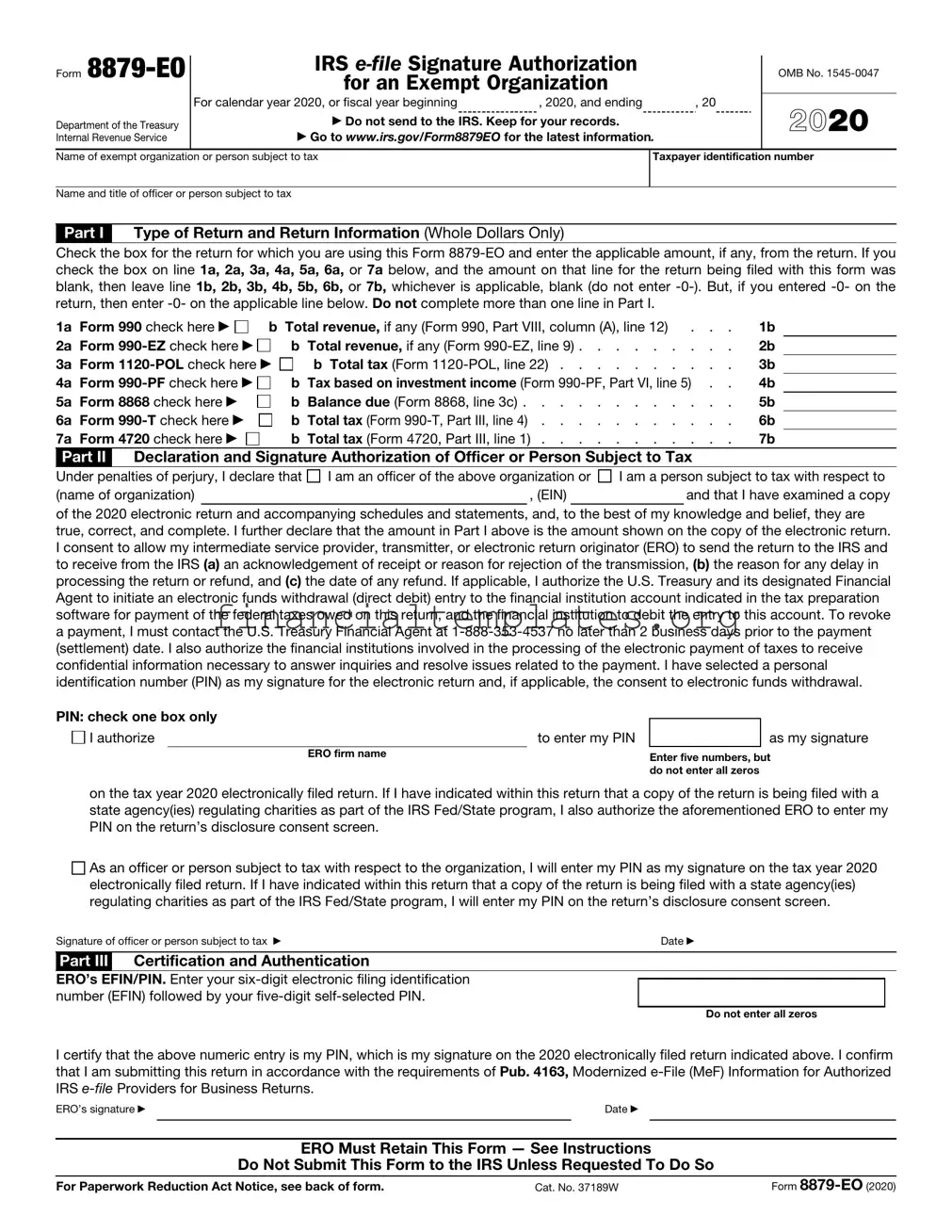Form 8879-EO
Department of the Treasury Internal Revenue Service
IRS E-FILE Signature Authorization
for an Exempt Organization
For calendar year 2020, or fiscal year beginning |
, 2020, and ending |
, 20 |
▶Do not send to the IRS. Keep for your records.
▶Go to WWW.IRS.GOV/FORM8879EO for the latest information.
Name of exempt organization or person subject to tax
Taxpayer identification number
Name and title of officer or person subject to tax
Part I Type of Return and Return Information (Whole Dollars Only)
Check the box for the return for which you are using this Form 8879-EO and enter the applicable amount, if any, from the return. If you check the box on line 1a, 2a, 3a, 4a, 5a, 6a, or 7a below, and the amount on that line for the return being filed with this form was blank, then leave line 1b, 2b, 3b, 4b, 5b, 6b, or 7b, whichever is applicable, blank (do not enter -0-). But, if you entered -0- on the return, then enter -0- on the applicable line below. Do not complete more than one line in Part I.
b Total revenue, if any (Form 990, Part VIII, column (A), line 12) . . . |
1b |
|
|
|
|
|
|
2a |
Form 990-EZ check here ▶ |
b Total revenue, if any (Form 990-EZ, line 9) |
2b |
|
3a |
Form 1120-POL check here ▶ |
b Total tax (Form 1120-POL, line 22) |
3b |
|
4a |
Form 990-PF check here ▶ |
b Tax based on investment income (Form 990-PF, Part VI, line 5) . . |
4b |
|
5a |
Form 8868 check here ▶ |
b Balance due (Form 8868, line 3c) |
5b |
|
6a |
Form 990-T check here ▶ |
b Total tax (Form 990-T, Part III, line 4) |
6b |
|
7a |
Form 4720 check here ▶ |
b Total tax (Form 4720, Part III, line 1) |
7b |
Part II |
Declaration and Signature Authorization of Officer or Person Subject to Tax |
|
|
Under penalties of perjury, I declare that 
 I am an officer of the above organization or
I am an officer of the above organization or 
 I am a person subject to tax with respect to
I am a person subject to tax with respect to
(name of organization), (EIN)and that I have examined a copy of the 2020 electronic return and accompanying schedules and statements, and, to the best of my knowledge and belief, they are true, correct, and complete. I further declare that the amount in Part I above is the amount shown on the copy of the electronic return. I consent to allow my intermediate service provider, transmitter, or electronic return originator (ERO) to send the return to the IRS and to receive from the IRS (a) an acknowledgement of receipt or reason for rejection of the transmission, (b) the reason for any delay in processing the return or refund, and (c) the date of any refund. If applicable, I authorize the U.S. Treasury and its designated Financial Agent to initiate an electronic funds withdrawal (direct debit) entry to the financial institution account indicated in the tax preparation software for payment of the federal taxes owed on this return, and the financial institution to debit the entry to this account. To revoke a payment, I must contact the U.S. Treasury Financial Agent at 1-888-353-4537 no later than 2 business days prior to the payment (settlement) date. I also authorize the financial institutions involved in the processing of the electronic payment of taxes to receive confidential information necessary to answer inquiries and resolve issues related to the payment. I have selected a personal identification number (PIN) as my signature for the electronic return and, if applicable, the consent to electronic funds withdrawal.
PIN: check one box only
I authorize |
to enter my PIN |
ERO firm name
as my signature
Enter five numbers, but do not enter all zeros
on the tax year 2020 electronically filed return. If I have indicated within this return that a copy of the return is being filed with a state agency(ies) regulating charities as part of the IRS Fed/State program, I also authorize the aforementioned ERO to enter my PIN on the return’s disclosure consent screen.
As an officer or person subject to tax with respect to the organization, I will enter my PIN as my signature on the tax year 2020 electronically filed return. If I have indicated within this return that a copy of the return is being filed with a state agency(ies) regulating charities as part of the IRS Fed/State program, I will enter my PIN on the return’s disclosure consent screen.
Signature of officer or person subject to tax ▶ |
Date ▶ |
Part III Certification and Authentication
ERO’s EFIN/PIN. Enter your six-digit electronic filing identification number (EFIN) followed by your five-digit self-selected PIN.
Do not enter all zeros
I certify that the above numeric entry is my PIN, which is my signature on the 2020 electronically filed return indicated above. I confirm that I am submitting this return in accordance with the requirements of Pub. 4163, Modernized e-File (MeF) Information for Authorized IRS e-file Providers for Business Returns.
ERO’s signature ▶Date ▶
ERO Must Retain This Form — See Instructions
Do Not Submit This Form to the IRS Unless Requested To Do So
For Paperwork Reduction Act Notice, see back of form. |
Cat. No. 37189W |
Form 8879-EO (2020) |



 I am an officer of the above organization or
I am an officer of the above organization or 
 I am a person subject to tax with respect to
I am a person subject to tax with respect to